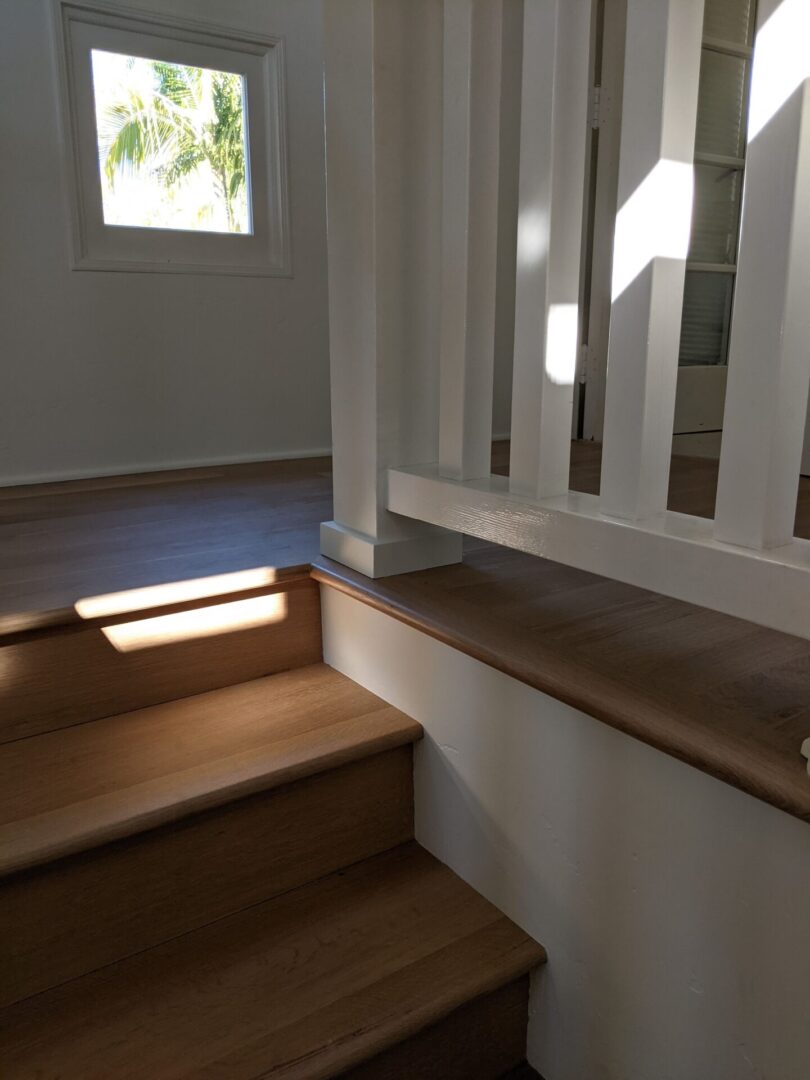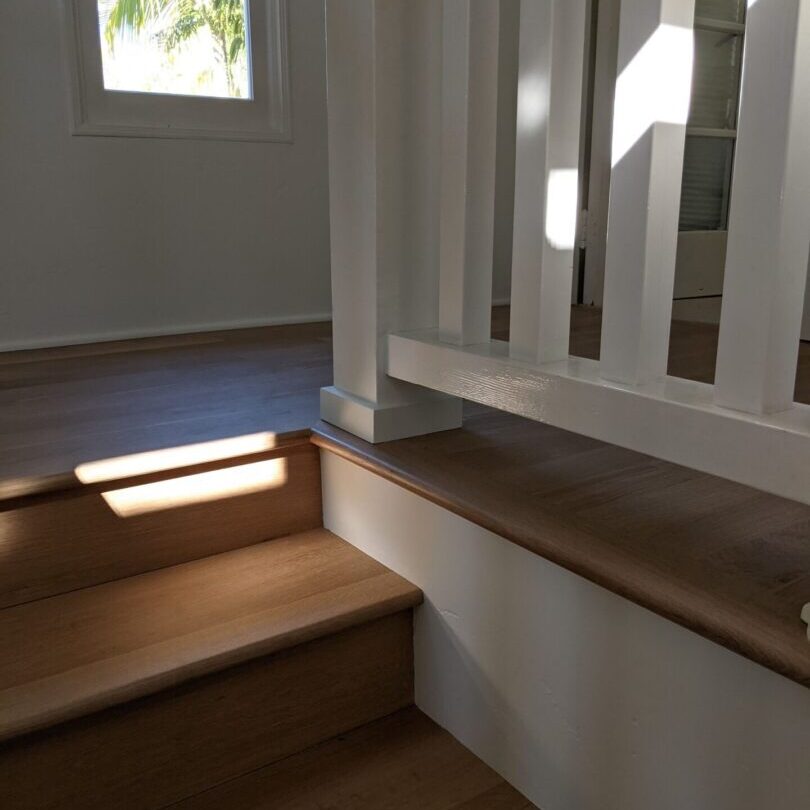Dedicated to Creating Beautiful Floors
805 Hardwood Flooring in Santa Barbara, California provides exceptional flooring solutions to residents and businesses. Our services cover a variety of areas, including:
Sanding & Refinishing
Hardwood Floor Installation
Custom Wood Staircase Installation
Engineered Flooring Installation
Custom Wood Molding
LVT Floor Installation
Buff & Coat Rejuvenation
Demolition
Extra Floor Prep
Gym Flooring
Reach Out to Us
To request a quote for our services, don’t hesitate to contact us. We hope to get the opportunity to serve you.


FAQ’S
One of the most popular types of hardwood underlayment is felt. It provides basic moisture resistance and sound absorption. Upon your choice you can choose heavier layers of black felt for additional insulation, sound absorption, and moisture resistance.
Given that the actual surface of engineered wood flooring is the same as that of solid hardwood flooring, the two are both equally resistant to scratching. Instead, the main factor in their scratch-resistance is how they’re treated.
The answer depends on a number of factors, such as the size of the project (how many rooms) and the type of hardwood floor you select. Keep in mind, every project and home are unique. However, on average it takes 7-10 days to install a hardwood floor once it has arrived at your home – 7 days for acclimation of the hardwood and 1-3 days for the actual floor installation.
The prefinished hardwood floor is sealed with multiple coats of finish at the factory. The finish coats typically contain aluminum oxide, the second hardest substance next to diamond, to provide a hard-wearing protective finish. Unfinished flooring must be finished on site after installation takes place. Aluminum oxide cannot be used in the finish on site because the longer drying time causing the aluminum oxide particles to sink to the bottom of the finish. Site-finished floors usually are better at protecting against above floor moisture.
Engineered hardwood floors can be floated, but not solid hardwood floors.
To acclimate the hardwood flooring, leave it inside the room it will be installed in, with the boxes open, for at least 5 to 7 days. This way it gets used to the conditions in the room before being used. In rooms where there are extreme humidity issues, it may be necessary to install a system such as a humidifier or dehumidifier to control the environment in the room.
Moisture can cause many different problems for a hardwood floor, such as cracking, cupping, and crowning. Over time, excessive moisture will destroy a wood floor, so it is suggested not to use excessive water to clean the hardwood floors and to mop up spills, immediately.
An acceptable moisture content runs anywhere from 4 to 18% depending on a variety of factors including the species of wood, where the wood floor is installed geographically, and the time of year. As a result, most wood used for flooring is kiln dried to 6 to 9% moisture content to assist in keeping it from getting so wet it contracts and so dry it shrinks.
Yes, as the barrier will help prevent water from getting to the floor and causing damage. Install the barrier between the subfloor and hardwood flooring.
There is water caught between the wood flooring and the subfloor if crowing or cupping occurs. Crowning is when the center boards are higher than the outer boards. Cupping is when the outer boards are higher than the center boards.
The best approach depends upon how the floor is finished: surface-sealed versus penetration-sealed. Ask your contractor for specifics and recommendations.
Wax based finishes and cleaners should never be used on any surface-sealed floors.
It is normal for certain species of hardwood floors that are exposed to sunlight to darken over time. To eliminate the obvious tone differences, it is best to rotate rugs and furniture so that the flooring gets an equal amount of sun exposure. Any differences in light exposure will eventually fade away.
Protecting the floor from early wear is as simple as establishing a consistent cleaning routine recommended by the manufacturer. This includes using damp cloths and/or vacuums rather than wet mops, employing the use of rugs, and using plastic or felt discs under furniture to keep the legs from
scratching the flooring surface.
It all varies. Hardwood floors finished with multiple coats of aluminum oxide finish. While this will certainly help the durability of the floor, it is the hardness of the floor that will give the best indication of durability
It is best to order about 5 to 10% more than you think you need to make sure there is enough. Take a good look at the room layout and consider your skill level in hardwood floor installation before making a final decision. You will want extra in case of boards that arrive damaged or are damaged during installation. It is also a good idea to have some extra boards for future repairs.
- The Quarter Round molding is used to hide the expansion gap left around walls during installation.
- The T molding is used as a threshold in doorways or as a transition strip where the hardwood flooring meets floor or carpet of similar height. T moldings can also be used to change the direction in which the floor is laid.
- The Reducer molding is used as a transition from the height of the sub-floor to the height of the hardwood floor.
- The Stair Nose molding is used to cover the front edge of a stair tread or step. If used on a stair, flooring is installed behind the Stair Nose to cover the horizontal part (the tread) of the stair.
- The Stair Tread molding is a one-piece molding used to entirely cover the structural stair tread.
Maintain hardwood flooring by establishing a consistent cleaning routine to prevent dirt and debris from scratching the surface. Use only recommended cleaning solutions, and avoid getting water on the floor. In high traffic areas, use a rug. Do not use harsh detergents on the floor and avoid using any abrasive materials to clean the floor, such as steel wool.
Hardwood flooring can be installed in virtually any room of a home except the bathroom. Essentially any area that is prone to wetness should avoid using hardwood. Only an engineered hardwood should be installed in the basement, as excessive moisture in these areas will cause solid hardwood to expand and contract. Highly trafficked areas should use a harder wood to ensure durability, but remember that even harder woods will show signs of wear and tear if not properly cared for.
There are many benefits of hardwood flooring including: an increased home value, variety of options and styles to customize the appearance, several installation methods, easy to clean and maintain, hypo-allergenic, warmth and durability.
There are many products on the market today designed to help restore the condition of a hardwood floor. Research these products and only use products recommended by the manufacturer to prevent further damage.
Color variations will be present in all grades of hardwood, as it is a natural product and cannot be controlled.
Thin profile solid wood (5/16” thick) can be installed over concrete. Standard ¾” solid hardwood should not be installed over concrete. However, it is possible with several additional steps. The concrete should be covered with a plastic sheet and sealed at all seams. Then, another moisture barrier, such as a plywood subfloor should be added to protect the flooring. Regardless, follow all manufacturers’ instructions carefully.
It is not recommended to use a solid hardwood over a concrete slab because of the swelling and contracting caused by excessive moisture. Using an engineered hardwood is the best way to install over a concrete slab because it is much less likely to swell and contract. Thin profile solid hardwood (5/16” thick) can also be installed over concrete.
This depends on the individual situation. If the vinyl is securely attached to the subflooring or has a strong cushion beneath it, it may be possible to float an engineered hardwood floor on top of it. Be sure to check with the manufacturer or seller.
Yes. It may not be able to be finished more than a few times because of the thickness of the veneer, but it can be done. Engineered floors that are hand scraped cannot be sanded and refinished or have a veneer thickness less than 2mm cannot be sanded and refinished.
While it is true many homeowners who have hardwood in their homes also have pets, this type of flooring can be scratched or dented by pet claws. A lot also depends on the type of the pets. Obviously, two Great Danes will have a bigger impact on a hardwood floor than a Toy Poodle. If pets will be inside, it is best to ensure that pet claws are kept trimmed. And, it is extremely important to clean up any “spills” immediately as these can permanently stain the wood.
Engineered flooring uses a veneer of real hardwood at the top which, depending on the thickness of the veneer, can be sanded down and refinished. As laminate flooring is nothing but a photographic image of the wood grain on engineered flooring, it cannot be sanded and refinished.
Real particle board will not be able to hold the hardwood well, causing it to loosen over time.
If the house is being built or restored, save the hardwood installation until the end to avoid potential issues with damage and moisture as other projects are being completed.
Yes, it is safe to use throw rugs on a hardwood floor to help protect the finish, provided they are color safe. This means the dyes will not run. If a rug is not color safe, the dye could seep into the wood and stain the flooring. It is best to use throw rugs and entranceways and in front of sinks to help protect the flooring from dirt and grit brought in from the outside and from moisture.
Gapping cannot be stopped completely, but by controlling the humidity in the home, it can be reduced.
Use plastic, foam or felt discs under all the furniture legs. These can be purchased at many retail stores, and are designed not only to reduce or prevent scratching, but also to reduce or prevent movement of the furniture all together.
Oil based cleaners will leave an oily residue on the flooring surface, making it more difficult to clean in the long run, while also increasing the signs of wear and tear.
If the wood floor has already been installed, not much can be done to help soundproof, as there are only two products, cork and another more expensive synthetic product, which must be glued to the subflooring before the hardwood is installed.
Try replacing individual boards of hardwood, or look for a patching compound recommended for use on the floor.
The only thing that can fix this problem is to sand and refinish the floors.
Air bubbles may not be the fault of the people who are applying the finish as each coat tends to dry a little bit faster than the one before it. Sand the floors a bit and reapply another coat. Try having this professionally done for the best results.
Removing a scratch depends on how deep the scratches are in the wood. Light scratches can be hidden using a repair kit suggested by the manufacturer. Deeper scratches may require board replacement.
If it is fresh paint, warm water and a damp cloth will do the job. If it’s dried on and has been there for a while, using something abrasive will be required, which means that part of the floor will need to be refinished.
